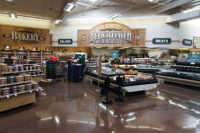Refrigeration equipment began its move away from HCFCs to HFCs before the air conditioning sector started its switchover. Supermarket systems have been using such HFCs as 404A and 507 for more than a decade. Even the refrigerated equipment that was designed for and installed with HCFC-22 is being targeted for retrofitting with a number of HFCs specifically designed to work in R-22 refrigerated systems. But even as all that goes on, new refrigerated equipment is being designed to run on so-called natural refrigerants such as ammonia, hydrocarbons, and CO2.
A Natural Choice
The biggest natural player in refrigeration, especially for supermarkets, is R-744 (CO2). It initially came into cooling and freezing applications in subcritical configurations. They often included HFCs in the design, but at much lower amounts than might have been needed in more conventional supermarket systems. This reduced the carbon footprint of a store and allowed owners to promote environmental awareness to customers who could be positively influenced by such claims.
But to be totally HFC-free meant CO2 systems had to go transcritical — something Europe has been doing for years. One of the first such systems in North America arrived in 2012 at an Urban Fare Express store in Vancouver, British Columbia, Canada.
The owners, Overwaitea Food Group (OFG), began experimenting with CO2 refrigeration systems in 2010 as part of an overall environmental commitment.
“Recycling, sustainable seafood, reusable bags, energy-efficient stores, and our efforts to be the No. 1 supporter of local products and producers are just some of the ways we show our commitment to sustainability every day,” said Carmen Hurcott, vice president of OFG.
To support this drive, the owners opted to use the Hillphoenix Advansor booster refrigeration system. “We chose a transcritical CO2 booster system because it is 100 percent HFC-free,” said Ralph Thiel, director for store planning and construction. “We’ve seen a number of synthetic refrigerants phased out over the years, and with their high global warming potential, we expect that eventually the current HFCs will be phased out too. CO2 transitions us to a natural refrigerant that we can live with in the future.”
The approach in Vancouver means that R-744 is the only refrigerant being used in medium- and low-temperature loads. The refrigerant’s high temperature rejection heat allows it to be used for hot-water heat-reclamation applications as well as hot gas defrosting.
Since CO2 systems operate under much higher pressures than conventional HFC-based systems, Hillphoenix officials noted that “many CO2 systems require steel piping throughout and carry a higher risk of pressure-related system breakdowns.”
However, Hillphoenix officials noted that this concern is eliminated with the use of Denmark-based Advansor A/S, which Hillphoenix acquired in 2011.
“The Advansor system eliminates those concerns by perfecting the use of pressure-reducing valves so that everything inside of the store operates under lower pressure, as it would with an HFC-based system,” said Hillphoenix representatives, in a press release. “Contractors can use copper piping and retailers can rest easy knowing that their Advansor system maintains pressures within a range normally found in traditional DX systems.”
In the case of the Urban Fare Express store, there is a backup auxiliary condensing unit on a backup generator in case of power failure. The smaller condensing unit cools the CO2 and keeps the pressure low to prevent the loss of the refrigerant.
Since R-744 is not a retrofit refrigerant for existing systems running on HCFCs or HFCs, the Urban Fare project required a completely new installation. But its 23,000 square feet were placed inside a structure that had once been part of the athletes’ village, heavily utilized in the 2010 Winter Olympics. Because the gas cooler was located in the garage area, sound-attenuating mufflers and ducts were required to move hot air outside of the garage.
Even though the cost of R-744 is considerably less per pound than any HFC, there has not yet been widespread switching to CO2. One reason is the installation and service learning curve for technicians. CO2 training centers are starting to appear, but CO2 education is not yet a widely taught, hands-on topic in most trade or vocational schools, or within HVACR colleges. Even those who have come through such programs need time to develop their own track record on a number of systems. Currently most CO2 work is being performed by OEMs.
Urban Fare’s Thiel is pragmatic about this and will continue to utilize the CO2 as its “natural” choice. “Our company is dedicated to CO2 in all new stores in urban settings and any location where there is a population base with enough tradesmen to be trained on CO2 technologies.”
Publication date: 4/1/2013











